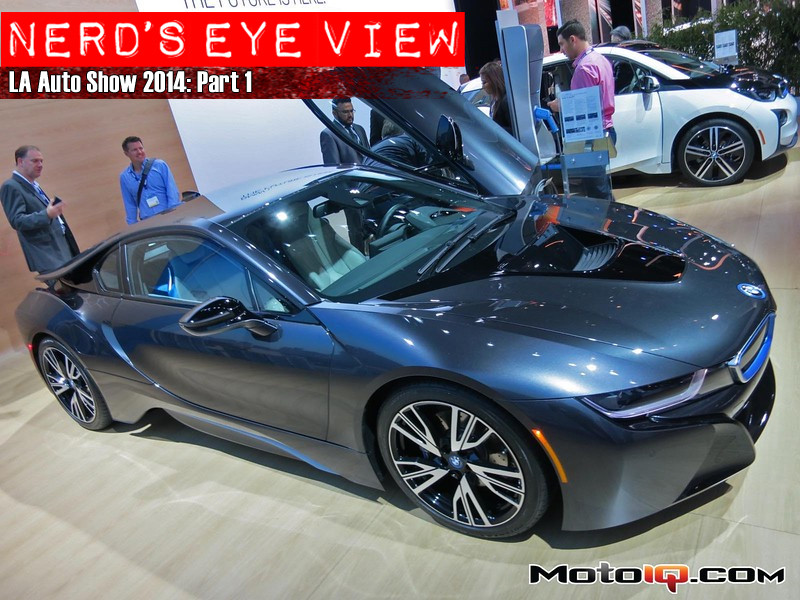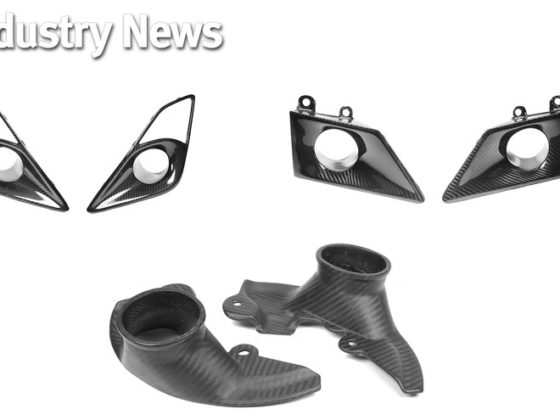,
 Part of my blurryness issue is due to these tasty bits in the Mercedes booth.
Part of my blurryness issue is due to these tasty bits in the Mercedes booth. So why pictures of this CUV thingy? Well, it is an AMG with similarly awesome seats to the AMG-GT. Check out the brakes on these thing along with the front splitter and little canards on the corners. This type of vehicle works will in the dense urban environments around LA with crowded and crappy streets. It’s relatively small to make it easier to maneuver in tighter areas with a bit more ground clearance for steeper driveways. Oh yeah, the roads are really bumpy and full of pot holes so a little bit more suspension travel versus a sedan should help though the low profile tires won’t be of much comfort. Hey, gotta make compromises somewhere.
So why pictures of this CUV thingy? Well, it is an AMG with similarly awesome seats to the AMG-GT. Check out the brakes on these thing along with the front splitter and little canards on the corners. This type of vehicle works will in the dense urban environments around LA with crowded and crappy streets. It’s relatively small to make it easier to maneuver in tighter areas with a bit more ground clearance for steeper driveways. Oh yeah, the roads are really bumpy and full of pot holes so a little bit more suspension travel versus a sedan should help though the low profile tires won’t be of much comfort. Hey, gotta make compromises somewhere. The heart is a highly boosted 2.0L turbocharged 4-cylinder packing 355hp! Yeah, that’s more power than a lot of V6 engines almost double in displacement. To get that much power out of this engine requires some optimized components. Check out the size of the intake tube going to the turbo! Cold air is grabbed from the front of the car into a big air box. The size of the air box is to allow for a big air filter for minimum pressure drop. That tube going from the air box to the turbo looks to be around 4” in diameter before shrinking down at the turbo. The tube is fat and short for minimum pressure drop. The length of the whole air path looks to be less than two feet for very minimal pressure drop!
The heart is a highly boosted 2.0L turbocharged 4-cylinder packing 355hp! Yeah, that’s more power than a lot of V6 engines almost double in displacement. To get that much power out of this engine requires some optimized components. Check out the size of the intake tube going to the turbo! Cold air is grabbed from the front of the car into a big air box. The size of the air box is to allow for a big air filter for minimum pressure drop. That tube going from the air box to the turbo looks to be around 4” in diameter before shrinking down at the turbo. The tube is fat and short for minimum pressure drop. The length of the whole air path looks to be less than two feet for very minimal pressure drop! Exiting the turbine side of the turbocharger is this massive downpipe. I’d venture a guess it is 3” diameter with a very nice radius and gentle bend for minimum flow restriction. My guess is what you see is the outer wall of a double wall stainless design for the downpipe with the outer wall providing thermal insulation to protect everything around it from heat. Even so, with this small of a displacement engine making so much power, there will be a ton of heat generated. So you’ll notice the massive heat shield on top of the turbocharger. The turbocharger sits on top of the exhaust manifold; so you can see the manifold below the turbo. The manifold is completely insulated also serving two purposes: keeping as much heat in before the turbine wheel maximizes performance (heat = energy to spool the turbo) and also keeping heat out of everything surrounding the manifold like hoses and electrical wires. Even with all the heat shielding on the turbocharger and manifold, notice there is heat shielding on the electrical box next to the radiator fan. Here is an interesting little tidbit I learned: the 4.0L V8 rated at about 500hp in the AMG-GT shares the same pistons, rods, and fuel injectors as this 2.0L 4-banger rated at 355hp. This information is a decent indicator the V8 can handle 700hp reliablily. It’ll be fun to see what the V8 can do with a bit of tuning and increased boost.
Exiting the turbine side of the turbocharger is this massive downpipe. I’d venture a guess it is 3” diameter with a very nice radius and gentle bend for minimum flow restriction. My guess is what you see is the outer wall of a double wall stainless design for the downpipe with the outer wall providing thermal insulation to protect everything around it from heat. Even so, with this small of a displacement engine making so much power, there will be a ton of heat generated. So you’ll notice the massive heat shield on top of the turbocharger. The turbocharger sits on top of the exhaust manifold; so you can see the manifold below the turbo. The manifold is completely insulated also serving two purposes: keeping as much heat in before the turbine wheel maximizes performance (heat = energy to spool the turbo) and also keeping heat out of everything surrounding the manifold like hoses and electrical wires. Even with all the heat shielding on the turbocharger and manifold, notice there is heat shielding on the electrical box next to the radiator fan. Here is an interesting little tidbit I learned: the 4.0L V8 rated at about 500hp in the AMG-GT shares the same pistons, rods, and fuel injectors as this 2.0L 4-banger rated at 355hp. This information is a decent indicator the V8 can handle 700hp reliablily. It’ll be fun to see what the V8 can do with a bit of tuning and increased boost. The air coming out of the turbocharger has a very short path into the air-to-water intercooler for maximum response and minimum pressure drop for maximum power. Yup, OEM style ribbed plastic end tanks are used on the metal air-to-water intercooler core. The distance the air has to travel from the compressor outlet to the throttle body is probably also less than two feet making a total path length of four feet or so. Compare that to an Evo X or Subaru STI where that’s about how far just the intake side has to travel.
The air coming out of the turbocharger has a very short path into the air-to-water intercooler for maximum response and minimum pressure drop for maximum power. Yup, OEM style ribbed plastic end tanks are used on the metal air-to-water intercooler core. The distance the air has to travel from the compressor outlet to the throttle body is probably also less than two feet making a total path length of four feet or so. Compare that to an Evo X or Subaru STI where that’s about how far just the intake side has to travel. Remember how bends in sheet metal add stiffness? The hood has this secondary sheet metal surface which is dimpled for stiffness and has cutouts for weight reduction.
Remember how bends in sheet metal add stiffness? The hood has this secondary sheet metal surface which is dimpled for stiffness and has cutouts for weight reduction. I suppose we’d all betterl get used to this view with the way drivetrain technologies are going. Just a button for ‘Park’ and R/N/D options.
I suppose we’d all betterl get used to this view with the way drivetrain technologies are going. Just a button for ‘Park’ and R/N/D options.


